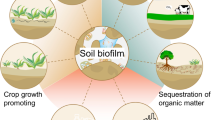Abstract
The low-temperature, methane-oxidizing activities and species composition of methanotrophic communities in various tundra bog soils were investigated by radioisotopic and immunofluorescent methods. Methanotrophic bacteria carried out the methane oxidation process through all horizons of seasonally thawed layers down to permafrost. The highest activity of the process has been observed in the water surface layer of overmoistured soils and in water-logged moss covers. Up to 40% of14CH4 added was converted into14CO2, bacterial biomass, and organic exometabolites. By immunofluoresecent analysis it was demonstrated that the representatives of I+X (Methylomonas, Methylobacter, andMethylococcus) and II (Methylosinus, Methylocystis) methanotrophic groups occurred simultaneously in all samples at 61.6% and 38.4%, respectively. The number of methane-oxidizing bacteria in the ecosystems studied was 0.1–22.9×106 cells per gram of soil. Methanotrophic organisms ranged from 1% to 23% of the total bacterial number.
Similar content being viewed by others
Literature Cited
Abramochkina FN, Bezrukova LV, Koshelev AV, Galchenko VF, Ivanov MV (1987) Microbial methane oxidation in a fresh-water reservoir. Mikrobiologija 56:465–471
Boohlol BB, Schmidt EL (1973) A fluorescent antibody technique for determination of growth rates of bacteria in soil. Bull Ecol Res Comm (Stockholm), vol. 7, pp. 336–338
Galchenko VF, Abramochkina FN, Bezrukova LV, Sokolova EN, Ivanov MV (1988) The species structure of aerobic methanotrophic microflora in the Black sea. Mikrobiologija 57:305–311
Galchenko VF, Ivanov MV, Lein A Yu (1989) Microbiological and biogeochemical process in oceanic water as indicators of submarine hydrotherm activity. Geokhimija 1075–1088
Whalen SC, Reeburgh WS (1990) Consumption of atmospheric methane by tundra soils. Nature 346:160–162
Whittenbury R, Colby J, Dalton H (1976) Biology and ecology and methane oxidizers. In: Goltze E (ed) Proceedings of symposium “Microbiol Production and Utilization of Gases.” Göttingen, pp 281–292
Yavitt JB, Lang GE, Downey DM (1988) Potential methane production and CH4 oxidation rates in peatland ecosystems of the Appalachian mountains, US. Global Biogeochem Cycles 2:254–268
Yavitt JB, Downey DM, Lancaster E, Lang GE (1990) Methane consumption in decomposing sphagnum derived peat. Soil Biol Biochem 22:441–447
Author information
Authors and Affiliations
Rights and permissions
About this article
Cite this article
Vecherskaya, M.S., Galchenko, V.F., Sokolova, E.N. et al. Activity and species composition of aerobic methanotrophic communities in tundra soils. Current Microbiology 27, 181–184 (1993). https://doi.org/10.1007/BF01576018
Published:
Issue Date:
DOI: https://doi.org/10.1007/BF01576018




